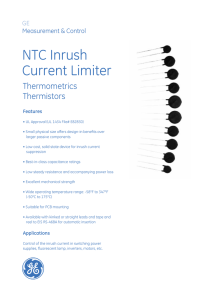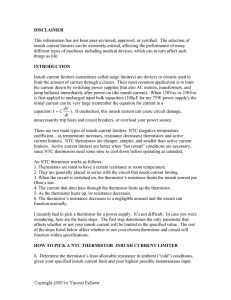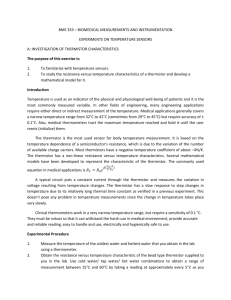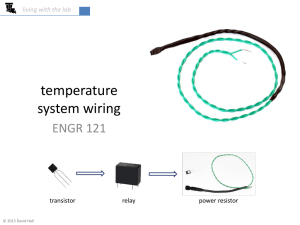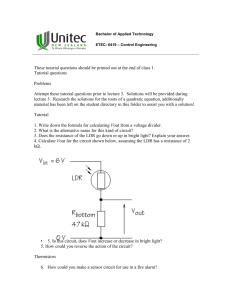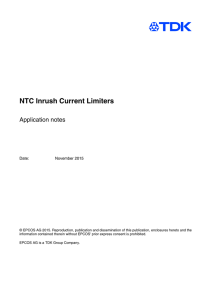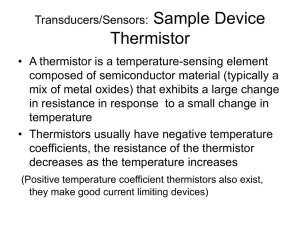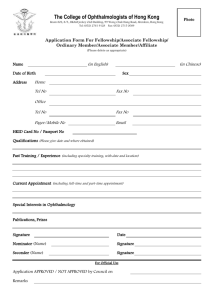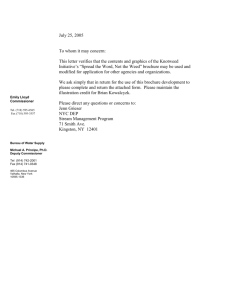ntc thermistors: type cl
advertisement
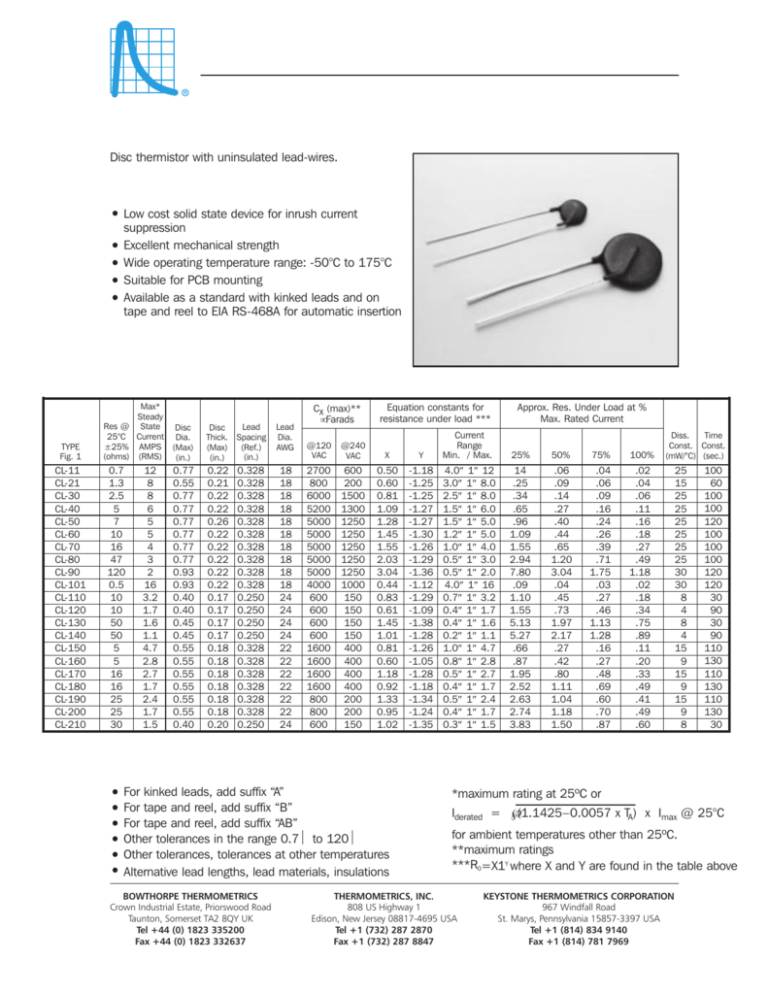
NTC THERMISTORS: TYPE CL NTC DISCS FOR INRUSH CURRENT LIMITING DESCRIPTION: Disc thermistor with uninsulated lead-wires. FEATURES: • Low cost solid state device for inrush current suppression • Excellent mechanical strength • Wide operating temperature range: -50°C to 175°C • Suitable for PCB mounting • Available as a standard with kinked leads and on tape and reel to EIA RS-468A for automatic insertion TYPE Fig. 1 CL-11 CL-21 CL-30 CL-40 CL-50 CL-60 CL-70 CL-80 CL-90 CL-101 CL-110 CL-120 CL-130 CL-140 CL-150 CL-160 CL-170 CL-180 CL-190 CL-200 CL-210 Max* Steady Res @ State Disc 25°C Current Dia. ±25% AMPS (Max) (ohms) (RMS) (in.) 0.7 1.3 2.5 5 7 10 16 47 120 0.5 10 10 50 50 5 5 16 16 25 25 30 12 8 8 6 5 5 4 3 2 16 3.2 1.7 1.6 1.1 4.7 2.8 2.7 1.7 2.4 1.7 1.5 0.77 0.55 0.77 0.77 0.77 0.77 0.77 0.77 0.93 0.93 0.40 0.40 0.45 0.45 0.55 0.55 0.55 0.55 0.55 0.55 0.40 Lead Disc Thick. Spacing (Ref.) (Max) (in.) (in.) 0.22 0.21 0.22 0.22 0.26 0.22 0.22 0.22 0.22 0.22 0.17 0.17 0.17 0.17 0.18 0.18 0.18 0.18 0.18 0.18 0.20 0.328 0.328 0.328 0.328 0.328 0.328 0.328 0.328 0.328 0.328 0.250 0.250 0.250 0.250 0.328 0.328 0.328 0.328 0.328 0.328 0.250 Lead Dia. AWG 18 18 18 18 18 18 18 18 18 18 24 24 24 24 22 22 22 22 22 22 24 Cx (max)** µFarads Equation constants for resistance under load *** @120 VAC @240 VAC X 2700 800 6000 5200 5000 5000 5000 5000 5000 4000 600 600 600 600 1600 1600 1600 1600 800 800 600 600 200 1500 1300 1250 1250 1250 1250 1250 1000 150 150 150 150 400 400 400 400 200 200 150 0.50 0.60 0.81 1.09 1.28 1.45 1.55 2.03 3.04 0.44 0.83 0.61 1.45 1.01 0.81 0.60 1.18 0.92 1.33 0.95 1.02 Approx. Res. Under Load at % Max. Rated Current Y Current Range Min. I / Max. I 25% 50% 75% 100% -1.18 -1.25 -1.25 -1.27 -1.27 -1.30 -1.26 -1.29 -1.36 -1.12 -1.29 -1.09 -1.38 -1.28 -1.26 -1.05 -1.28 -1.18 -1.34 -1.24 -1.35 4.0≤ 1≤ 12 3.0≤ 1≤ 8.0 2.5≤ 1≤ 8.0 1.5≤ 1≤ 6.0 1.5≤ 1≤ 5.0 1.2≤ 1≤ 5.0 1.0≤ 1≤ 4.0 0.5≤ 1≤ 3.0 0.5≤ 1≤ 2.0 4.0≤ 1≤ 16 0.7≤ 1≤ 3.2 0.4≤ 1≤ 1.7 0.4≤ 1≤ 1.6 0.2≤ 1≤ 1.1 1.0≤ 1≤ 4.7 0.8≤ 1≤ 2.8 0.5≤ 1≤ 2.7 0.4≤ 1≤ 1.7 0.5≤ 1≤ 2.4 0.4≤ 1≤ 1.7 0.3≤ 1≤ 1.5 14 .25 .34 .65 .96 1.09 1.55 2.94 7.80 .09 1.10 1.55 5.13 5.27 .66 .87 1.95 2.52 2.63 2.74 3.83 .06 .09 .14 .27 .40 .44 .65 1.20 3.04 .04 .45 .73 1.97 2.17 .27 .42 .80 1.11 1.04 1.18 1.50 .04 .06 .09 .16 .24 .26 .39 .71 1.75 .03 .27 .46 1.13 1.28 .16 .27 .48 .69 .60 .70 .87 .02 .04 .06 .11 .16 .18 .27 .49 1.18 .02 .18 .34 .75 .89 .11 .20 .33 .49 .41 .49 .60 OPTIONS: DATA: • For kinked leads, add suffix “A” • For tape and reel, add suffix “B” • For tape and reel, add suffix “AB” • Other tolerances in the range 0.7Ω to 120Ω • Other tolerances, tolerances at other temperatures • Alternative lead lengths, lead materials, insulations *maximum rating at 25ºC or BOWTHORPE THERMOMETRICS Crown Industrial Estate, Priorswood Road Taunton, Somerset TA2 8QY UK Tel +44 (0) 1823 335200 Fax +44 (0) 1823 332637 Iderated = Diss. Time Const. Const. (mW/°C) (sec.) 25 15 25 25 25 25 25 25 30 30 8 4 8 4 15 9 15 9 15 9 8 100 60 100 100 120 100 100 100 120 120 30 90 30 90 110 130 110 130 110 130 30 √(1.1425–0.0057 x TA) x Imax @ 25°C for ambient temperatures other than 25ºC. **maximum ratings ***R0=X1Y where X and Y are found in the table above THERMOMETRICS, INC. 808 US Highway 1 Edison, New Jersey 08817-4695 USA Tel +1 (732) 287 2870 Fax +1 (732) 287 8847 KEYSTONE THERMOMETRICS CORPORATION 967 Windfall Road St. Marys, Pennsylvania 15857-3397 USA Tel +1 (814) 834 9140 Fax +1 (814) 781 7969 NTC THERMISTORS: TYPE CL NTC DISCS FOR INRUSH CURRENT LIMITING RI -tº TYPICAL POWER SUPPLY CIRCUIT INRUSH CURRENT LIMITERS IN SWITCHING POWER SUPPLIES • • The problem of current surges in switch-mode power supplies is caused by the large filter capacitors used to smooth the ripple in the rectified 60Hz current prior to being chopped at a high frequency. The diagram above illustrates a circuit commonly used in switching power supplies. • • • In the circuit above the maximum current at turn-on is the peak line voltage divided by the value of R; for 120v, it is approximately 120 x 公2/RI. Ideally, during turn-on RI should be very large, and after the supply is operating, should be reduced to zero. The NTC thermistor is ideally suited for this application. It limits surge current by functioning as a power resistor which drops from a high cold resistance to a low hot resistance when heated by the current flowing through it. Some of the factors to consider when designing NTC thermistor as an inrush current limiter are: BOWTHORPE THERMOMETRICS Crown Industrial Estate, Priorswood Road Taunton, Somerset TA2 8QY UK Tel +44 (0) 1823 335200 Fax +44 (0) 1823 332637 Maximum permissible surge current at turn-on Matching the thermistor to the size of the filter capacitors Maximum value of steady state current Maximum ambient temperature Expected life of the power supply Maximum Surge Current The main purpose of limiting inrush current is to prevent components in series with the input to the DC/DC convertor from being damaged. Typically, inrush protection prevents nuisance blowing of fuses or breakers as well as welding of switch contacts. Since most thermistor materials are very nearly ohmic at any given temperature, the minimum no-load resistance of the thermistor is calculated by dividing the peak input voltage by the maximum permissible surge current in the power supply (Vpeak/Imax surge). THERMOMETRICS, INC. 808 US Highway 1 Edison, New Jersey 08817-4695 USA Tel +1 (732) 287 2870 Fax +1 (732) 287 8847 KEYSTONE THERMOMETRICS CORPORATION 967 Windfall Road St. Marys, Pennsylvania 15857-3397 USA Tel +1 (814) 834 9140 Fax +1 (814) 781 7969 Energy Surge at Turn-On At the moment the circuit is energized, the filter caps in a switcher appear like a short circuit which, in a relatively short period of time, will store an amount of energy equal to 1⁄2CV2. All of the charge that the filter capacitors store must flow through the thermistor. The net effect of this large current surge is to increase the temperature of the thermistor very rapidly during the period the capacitors are charging. The amount of energy generated in the thermistor during this capacitor-charging period is dependent on the voltage waveform of the source charging the capacitors. However, a good approximation for the energy generated by the thermistor during this period is 1⁄2CV2 (energy stored in the filter capacitor). The ability of the NTC thermistor to handle this energy surge is largely a function of the mass of the device. This logic can be seen in the energy balance equation for a thermistor being self-heated: As more current flows through the device, its steady-state operating temperature will increase and its resistance will decrease. The maximum current rating correlates to a maximum allowable temperature. In the table of standard inrush current limiters is a list of values for resistance under load for each unit, as well as a recommended maximum steady-state current. These ratings are based upon standard PC board heat sinking, with no air flow, at an ambient temperature of 25°C. However, most power supplies have some air flow, which further enhances the safety margin that is already built into the maximum current rating. To derate the maximum steady state current for operation at elevated ambient temperatures, use the following equation: Iderated = √(1.1425–0.0057 x TA) x Imax @ 25°C Input Energy = Energy Stored + Energy Dissipated o r in differential form: where: P = t = H = T = δ = TA = Pdt = HdT + δ(T – TA)dt Power generated in the NTC Time Heat capacity of the thermistor Temperature of the thermistor body Dissipation constant Ambient temperature During the short time that the capacitors are charging (usually less than 0.1 second), very little energy is dissipated. Most of the input energy is stored as heat in the thermistor body. In the table of standard inrush limiters there is listed a recommended value of maximum capacitance at 120 volts and 240 volts. This rating is not intended to define the absolute capabilities of the thermistors; instead, it is an experimentally determined value beyond which there may be some reduction in the life of the inrush current limiter. Maximum Steady-State Current The maximum steady-state current rating of a thermistor is mainly determined by the acceptable life of the final products for which the thermistor becomes a component. In the steady-state condition, the energy balance in the differential equation already given reduces to the following heat balance formula: Power = I2R = δ(T – TA) BOWTHORPE THERMOMETRICS Crown Industrial Estate, Priorswood Road Taunton, Somerset TA2 8QY UK Tel +44 (0) 1823 335200 Fax +44 (0) 1823 332637 Inrush Current Limiters THERMOMETRICS, INC. 808 US Highway 1 Edison, New Jersey 08817-4695 USA Tel +1 (732) 287 2870 Fax +1 (732) 287 8847 KEYSTONE THERMOMETRICS CORPORATION 967 Windfall Road St. Marys, Pennsylvania 15857-3397 USA Tel +1 (814) 834 9140 Fax +1 (814) 781 7969

